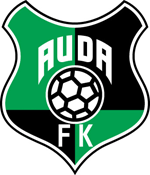| Season | 1924 |
|---|---|
| Matches played | 10 |
| Goals scored | 25 (2.5 per match) |
← 1923 1925 → | |
This article needs additional citations for verification .(December 2011) |
Statistics of Latvian Higher League in the 1924 season.[ citation needed ]
| Season | 1924 |
|---|---|
| Matches played | 10 |
| Goals scored | 25 (2.5 per match) |
← 1923 1925 → | |
This article needs additional citations for verification .(December 2011) |
Statistics of Latvian Higher League in the 1924 season.[ citation needed ]
RFK won the championship.[ citation needed ]
| Pos | Team | Pld | W | D | L | GF | GA | GD | Pts |
|---|---|---|---|---|---|---|---|---|---|
| 1 | RFK | 4 | 4 | 0 | 0 | 11 | 1 | +10 | 8 |
| 2 | ASK | 4 | 2 | 1 | 1 | 4 | 4 | 0 | 5 |
| 3 | Amatieris | 4 | 2 | 0 | 2 | 6 | 9 | −3 | 4 |
| 4 | JKS | 4 | 1 | 0 | 3 | 1 | 4 | −3 | 2 |
| 5 | LSB | 4 | 0 | 1 | 3 | 3 | 7 | −4 | 1 |
Kaiserwald withdrew after 2 rounds because of the decision of Latvia Football Union (LFS - Latvijas Futbola Savieniba) which prohibited foreign players to participate in the championship. [1]
2nd stage: RFK [Riga] - Cesu VB [Cesis] 5-1

The San Marino national football team represents San Marino in men's international association football competitions. The team is controlled by the San Marino Football Federation and represents the smallest population of any UEFA member.

The Andorra national football team represents Andorra in association football and is controlled by the Andorran Football Federation, the governing body for football in Andorra. The team has enjoyed very little success due to the Principality's tiny population, the fifth smallest of any UEFA country.

Futbola klubs Auda is a Latvian football club, playing in the highest division of Latvian football. They are based in Ķekava, near the capital, Riga. Auda won their first ever major trophy in 2022, beating RFS 1–0 in the final of the Latvian Cup.
Riga FK was a Latvian football club which was founded December 14, 1923. It was the strongest and most popular Latvian football club in 1920s and 1930s, it was also the base team for Latvia national football team in its early years. It was closed after World War II.
The 1992 season in the Latvian Higher League, named Virslīga, was the second football (soccer) domestic competition since the Baltic nation gained independence from the Soviet Union on 6 September 1991. Twelve teams competed in this edition, with Skonto FC claiming the title.
Edvīns Bārda was a Latvian footballer and manager, the elder and most popular of four football playing Bārda brothers.
Česlavs Stančiks was a Latvian footballer. In 1939 he resettled in Germany as part of resettlement of all Baltic Germans.
Karlis Arvīds Jurgens was a Latvian footballer, ice hockey, basketball and bandy player who play played for Latvia national teams in all four of these sports. He was one of the best all-around Latvian sportsmen.
Jānis Škincs was a Latvian footballer, a four-time champion of Latvia. Škincs was known as one of the fastest forwards in Latvian football.
In 1942 under German occupation most pre-war Latvian football clubs were restored. The championship was divided in two phases - the preliminary phase to determine the four strongest sides in Riga and two in the province, and the main phase where these six teams would settle among them positions in the Latvian Higher League.
The 1939–40 football season was the 13th season of the Latvian Virsliga. It was also the last season of football in independent Latvia before its annexation by the Soviet Union.
Statistics of Latvian Higher League in the 1925 season.
Statistics of the Latvian Higher League for the 1926 season- RFK were the league champions:
Statistics of Latvian Higher League in the 1930 season.
Statistics of Latvian Higher League in the 1934 season.
Statistics of Latvian Higher League in the 1935 season.
The 1921 Latvian Football Championship was the first Latvian Football Championship, it was contested by four teams with Kaiserwald winning the championship. The championship was not completed due to the unexpectedly early winter.
The 1945 Soviet football championship was the 13th season of competitive football in the Soviet Union and the 7th featuring teams hailing from sports societies and factories. It also was the first full season with league competitions after World War II. The tiers were renamed after World War II, with Group A being renamed to First Group and Group B renamed to Second Group. FC Dynamo Moscow won the championship, becoming the Soviet domestic champions for the fourth time.
The 1990 Soviet football championship was the 59th seasons of competitive football in the Soviet Union. Dinamo Kiev won the Top League championship becoming the Soviet domestic champions for the thirteenth time.
The 1940 Soviet football championship was the 10th seasons of competitive football in the Soviet Union. Dinamo Moscow won the championship becoming the winner of Group A for the third time.